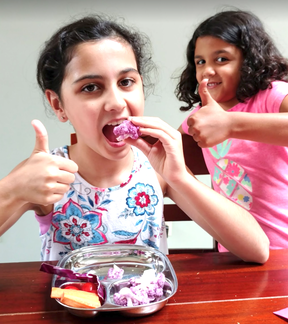|
How have you been eating lately? Most people answer this question with an explanation of their diet, by listing specific foods that they eat, and maybe sharing whether or not they think they should be eating them. To get even more specific about how you eat, consider questions such as:
How we eat mattersTaking inventory of your habitual eating practices is a fairly new concept known as eating hygiene. This practice will help you set a foundation to begin working toward better digestion. Eating hygiene includes the circumstances, pace, and details involved in consuming a meal. In my college years and through early adulthood, I’d often slap a sandwich together or get fast food and eat on the go. Eating was for me, for many years, a necessity; something I considered simply a function on the way to more important things. I wasn’t picky, and along with that, I did not take time to savor my food. I didn’t see it as a time of enjoyment, self care, or nourishment. It never occurred to me to make eating a time to rest and be mindful of my body. Old habits die hard, and this is an area that I still must work to prioritize when life gets busy. Personal meals are important, as are family meals. Shared family mealtimes at least three times a week include several benefits: a reduced risk for becoming overweight, a reduced risk of eating unhealthy foods, and reduced risk for developing eating disorders (1). When we prioritize meals together, we not only increase our likelihood of eating healthier foods, but also create a positive routine and accountability with our family members. How we eat is a solid foundation for enhancing the assimilation of nutrients from what we eat. Digestion: it all starts in the mouth  Kids are usually great at chewing properly! Kids are usually great at chewing properly! Digestion begins with our mouth watering when we first see or smell food. Our body is gearing up to enjoy that giant slice of cauliflower-crust, pesto veggie-loaded pizza from the moment we lay eyes on it. Thorough chewing sets the stage for the rest of the digestive process. After swallowing, the food descends into the stomach. This chewed-up food is referred to as a bolus. The bolus then mixes with stomach acid to begin breaking down proteins and micronutrients. This ensures the nutrients are small enough to be easily absorbed by the body. Once the stomach acid does its work, the bolus becomes chyme. Chyme is the liquid combination of stomach acid and chewed-up food. The chyme descends into the upper part of the small intestines called the duodenum. While there, the gallbladder and pancreas release more digestive fluids to break down fats. At this point, the chewed, swallowed, acidified, and bile-infused chyme concoction makes its way through the long tunnel of the small intestine. What was once an appetizing meal has been broken down into nutrients for the body to absorb and use for energy, repair, growth and more. Ultimately, the large intestine absorbs water and vitamins from the chyme and moves the waste out of the body. When we begin this fascinating process by chewing our food well (between 15-30 chews per bite), we have the potential to reduce digestive pain, bloating, gas, post-meal fatigue, and even reflux. Appropriate chewing lessens the burden of work on the other phases of digestion that follow. Fight-or-flight vs. Rest-and-digest When we take time to slow down, breathe, and prepare a place for ourselves to eat in a stress-free, calm environment, we send signals to our body that activates our parasympathetic nervous system (PNS). The PNS experience allows our body to rest and digest, relax, and support our immune function. It sends messages to our brain and body that our environment is safe. When our PNS is stimulated, we achieve balance, calm, and relaxation. When we eat in a relaxed state of being, our digestive system can focus on doing its job, making way for easy passage and distribution of nutrients throughout the body. When our body recognizes these safe signals, it allows the PNS relaxation hormones to release (2). On the other hand, if we’re rushing to a meeting, shoveling food into our mouths while en route to the next activity, or standing up and mindlessly nibbling on the food we’re preparing for our children (guilty!), we are more likely to be activating our sympathetic nervous system (SNS) instead of the PNS (where we want to be). The SNS experience, also referred to as fight-or-flight, is designed to be temporary and fleeting. It’s what gets our heart pumping faster, dumps adrenaline into our bodies, and primes us to fight hard or run for our lives. But guess what? When our body is full of stress hormones from the SNS experience, and primed to run from a bear, it doesn’t expect to take in and optimally digest any amount of food at the same time. When our body is in a stressed state, it actually reduces our digestive secretions, alters gastrointestinal motility, enhances permeability in the intestines, and has negative effects on our gut microbiome (3). This being the case, it should come as no surprise that indigestion, discomfort, belching, or fatigue would follow that 4-minute shoveling of an entire sandwich while rushing off to a meeting. For a comparison of the two different stress responses to the common experience of walking in a park, check out this site (4). You control your chewing qualityChewing is the only part of digestion which is under our voluntary control, meaning you get to choose how thoroughly this digestive process is accomplished. Once food is swallowed, digestion is out of your hands (mouth), and is dependent upon your body’s interpretation of the messages received from its environment. Those environmental stress signals can alter digestion both immediately and over longer periods of time (3). If we are stressed (in SNS), we can surely expect that our digestion (which thrives in PNS) will be subpar. Many times, we look for a quick fix—a magic pill or new technique to make us feel better and bring healing. Thorough chewing might be the simplest support you can implement into your wellness routine. By adopting these simple strategies while eating, you may be surprised by some drastic positive improvements:
What might it look like to make your meal a time of self-care? How are you eating now? What does chewing look like for you? Ideally, we should chew each bite 15-30 times, enough to slowly enjoy the flavors and safely swallow. When we first see or smell food, our mouth waters–this is the release of saliva, the first digestive fluid that comes into contact with our food. Digestion is getting primed before we even raise the fork. It is possible to use this knowledge to our advantage and consider the beginning of meals as a time for mindful awareness. Eating with mindful awarenessDuke Integrative Medicine explains that mindful awareness is “about waking up, being fully alive, and being present for the richness of each moment of our lives.” Doesn’t that sound like a delightful way to enjoy a meal? When a person incorporates principles and practices of mindful awareness they begin to “gain access to [their] deepest inner resources for living, healing, and coping with stress.” (5) Incorporating mindful awareness into eating may first begin with sitting down. In a calm space, beginning with your eyes, appreciate the meal that is set before you. Speak a prayer or sentence of gratitude for the food. Notice the colors, textures and aromas that accompany each bite. Thorough chewing is a boon to our taste buds, too. As carbohydrates are chewed and further broken down, they become sweeter in the mouth (6). Rushed chewing would mean completely missing this sensation. Spending at least 15-20 minutes (or longer) to thoroughly chew and finish a meal allows sufficient time for our body to release hunger-regulating hormones (7). To prolong your meal, consider purposefully setting down your fork in between bites to take a breath and slow yourself down. Manners come in handy for digestion, too. By choosing to prioritize chewing before talking or responding to your table-mates, you avoid talking with a full mouth. Ready, set, chew!Are you ready for a chewing challenge? How might you remind yourself of this new commitment?
Here are a few ideas:
However you incorporate your new eating hygiene knowledge, as with any change, remember that it is a process. You will have meals that absolutely have to be on-the-go, or you’ll forget, and that’s okay. Be kind to yourself and remember that all wellness is a journey. We continue to learn and graft new knowledge and insights into our daily routines until, over time, those new, better routines replace the old ones. Breathe, relax, chew thoroughly, and enjoy your meals. > For a delightful, entertaining, and informative read on digestion (plus helpful and comedic illustrations!) I recommend “GUT” by Giulia Enders. > For more on stomach acid, check out “Why Stomach Acid Is Good For You” by Jonathan Wright. > For a partner in your health and wellness goals, including something as simple as chewing, book a session with one of our national board certified coaches. *The contents of this post are intended for general informational purposes only and are not to be construed as individualized advice. Please see a licensed medical professional for all individual concerns. References 1. Hammons AJ, Fiese BH. Is frequency of shared family meals related to the nutritional health of children and adolescents? Pediatrics. 2011; 127 (6): e1565-1574 2. Tindle J, Tadi P. Neuroanatomy, Parasympathetic Nervous System. [Updated 2020 Jan 11]. In: StatPearls [Internet]. Treasure Island (FL): StatPearls Publishing; 2020 Jan-. Available from: https://www.ncbi.nlm.nih.gov/books/NBK553141/ 3. Konturek, P. C., Brzozowski, T., & Konturek, S. J. (2011, December). Stress and the gut: pathophysiology, clinical consequences, diagnostic approach and treatment options. Retrieved from https://www.ncbi.nlm.nih.gov/pubmed/22314561 4. Neuroscience For Kids. (n.d.). Retrieved from https://faculty.washington.edu/chudler/auto.html 5. Mindfulness Based Stress Reduction. (2020, April 21). Retrieved from https://dukeintegrativemedicine.org/programs-training/public/mindfulness-based-stress-reduction/ 6. (n.d.). Retrieved from https://study.com/academy/answer/crackers-chewed-over-a-few-minutes-will-begin-to-taste-sweet-in-you-saliva-is-an-enzyme-called-amylase-which-will-hydrolyze-starch-explain-this-observation.html 7. (n.d.). Retrieved from https://www.yourhormones.info/hormones/cholecystokinin
0 Comments
Your comment will be posted after it is approved.
Leave a Reply. |
take control of your health.Connect with a board certified coach to help you succeed with health changes. COACHES:
|


